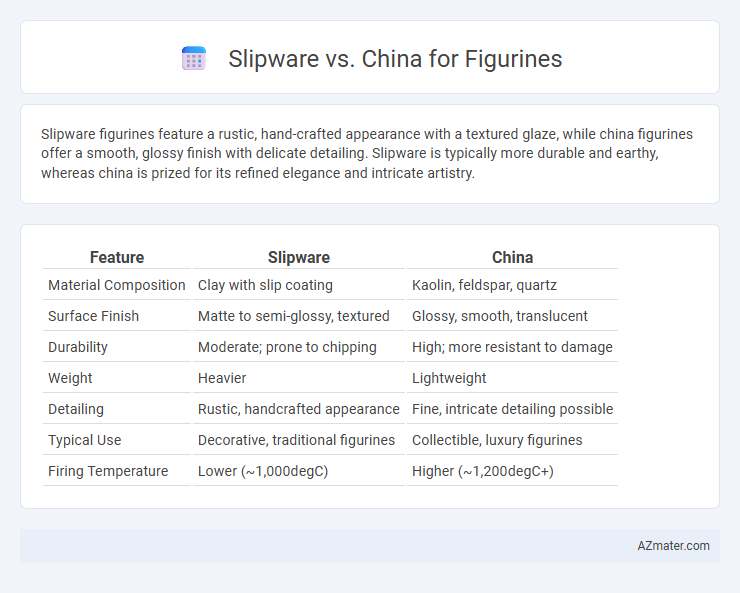Slipware figurines feature a rustic, hand-crafted appearance with a textured glaze, while china figurines offer a smooth, glossy finish with delicate detailing. Slipware is typically more durable and earthy, whereas china is prized for its refined elegance and intricate artistry.
Table of Comparison
| Feature | Slipware | China |
|---|---|---|
| Material Composition | Clay with slip coating | Kaolin, feldspar, quartz |
| Surface Finish | Matte to semi-glossy, textured | Glossy, smooth, translucent |
| Durability | Moderate; prone to chipping | High; more resistant to damage |
| Weight | Heavier | Lightweight |
| Detailing | Rustic, handcrafted appearance | Fine, intricate detailing possible |
| Typical Use | Decorative, traditional figurines | Collectible, luxury figurines |
| Firing Temperature | Lower (~1,000degC) | Higher (~1,200degC+) |
Introduction to Slipware and China Figurines
Slipware figurines are crafted using a clay body coated with liquid clay slip, which allows for detailed surface decoration and varied textures, making each piece unique in appearance. China figurines, often made from fine porcelain, are known for their delicate translucency, smooth finish, and high durability, established through sophisticated kiln firing techniques. While slipware emphasizes artisanal hand-decoration, china figurines showcase precision and refined glazing, reflecting different cultural and manufacturing traditions in ceramic artistry.
Historical Origins of Slipware and China
Slipware originated in ancient Mesopotamia around 3000 BCE, characterized by the application of liquid clay slip over earthenware to create decorative and functional figurines. In contrast, China's porcelain figurines emerged during the Tang Dynasty (618-907 CE), utilizing high-fired kaolin clay to produce delicate, translucent sculptures synonymous with imperial craftsmanship. The historical evolution of slipware reflects utilitarian folk traditions, whereas Chinese porcelain signifies technological innovation and refined artistry in ceramic figurines.
Material Composition: Slipware vs China
Slipware figurines are crafted using earthenware clay coated with a liquid clay slip, resulting in a porous, slightly textured surface with a matte finish. In contrast, China figurines are made from kaolin-based porcelain, characterized by a dense, non-porous structure and a glossy, smooth surface due to high-temperature firing. The differences in material composition affect durability, translucency, and the overall aesthetic quality of the figurines.
Distinctive Artistic Styles and Techniques
Slipware figurines showcase a tactile surface achieved by applying liquid clay slip to create textured patterns and earthy tones, emphasizing rustic and folk art aesthetics. Chinese porcelain figurines, particularly those made from fine china, are renowned for their delicate, smooth finish and intricate hand-painted designs featuring vibrant glazes and detailed motifs, reflecting refined craftsmanship and cultural symbolism. The contrasting artistic styles highlight slipware's emphasis on organic, handcrafted appeal versus china's focus on precision, translucency, and ornate decoration.
Durability and Longevity Differences
Slipware figurines offer enhanced durability due to their thick slip coating, which provides resistance against chipping and cracking compared to China figurines. China figurines, made from fine porcelain, are more delicate and prone to damage over time despite their smooth finish and intricate details. The longevity of slipware is generally superior in everyday use scenarios, while China requires careful handling to maintain its pristine appearance.
Popularity and Collectibility
Slipware figurines are prized for their unique, handcrafted glaze patterns and regional charm, attracting collectors who value artistic individuality and historic craftsmanship. China figurines, often produced by renowned manufacturers like Royal Doulton and Meissen, enjoy widespread popularity due to their fine porcelain quality and detailed, refined designs. Collectibility of slipware tends to emphasize rarity and folk art appeal, while china figurines command higher market value through brand prestige and intricate artistry.
Notable Artists and Manufacturers
Notable slipware figurine artists include Bernard Leach and Shoji Hamada, renowned for their mastery in salt-glazed and slip-decorated pottery, emphasizing organic textures and traditional craftsmanship. In contrast, famous Chinese porcelain figurine manufacturers such as Jingdezhen kilns, active since the Ming dynasty, are celebrated for delicate, finely detailed porcelain artworks often featuring intricate hand-painted designs. Both traditions highlight unique artistic techniques, with slipware emphasizing tactile surface decoration and Chinese porcelain focusing on translucency and precision.
Display and Care Considerations
Slipware figurines, made from earthenware clay with a liquid clay slip coating, require careful handling to prevent chipping and fading of their painted surfaces, making display in low-humidity, stable environments essential. China figurines, crafted from porcelain with a vitrified glaze, offer greater durability and resistance to moisture and dust, allowing for easier cleaning with a soft cloth and mild detergent without risking damage. Displaying china figurines on stable shelves away from direct sunlight helps preserve their gloss and intricate details, while slipware benefits from glass-enclosed cabinets to minimize exposure to environmental fluctuations.
Market Value and Investment Potential
Slipware figurines often hold niche market value due to their artisanal craftsmanship and unique glazing techniques, attracting collectors who appreciate historical and regional styles. China figurines, particularly those crafted from fine porcelain by renowned manufacturers like Meissen or Wedgwood, command higher market prices and offer stronger investment potential because of their global recognition and lasting appeal. Investment in China figurines tends to be more lucrative, benefiting from well-documented provenance and greater demand in international auction markets.
Choosing the Right Material for Figurines
Slipware offers a rustic, textured finish ideal for artisanal figurines, emphasizing durability and moldability with its earthenware base coated in liquid clay. China, particularly fine porcelain, delivers a smooth, translucent surface favored for intricate detailing and a polished, high-gloss appearance that enhances figurine elegance. Selecting the right material depends on the desired aesthetic, level of detail, and functional durability, with slipware suited for robust, earthy designs and china preferred for delicate, refined creations.

Infographic: Slipware vs China for Figurine
 azmater.com
azmater.com